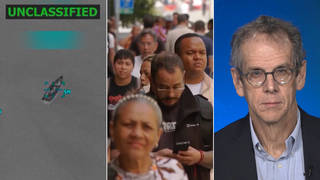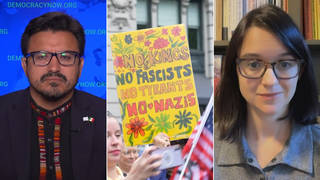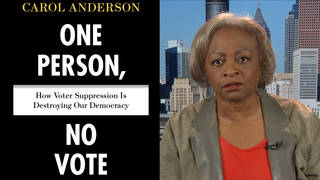
Topics
Guests
- Rob Richieco-founder and executive director of the electoral reform organization FairVote.
Links
“The path to 270” is the catch phrase used in media coverage of who will win the Electoral College, which raises the question: Will everyone’s vote count equally in determining the next president of the United States? Some analysts argue the 2016 election will come down to the same 11 states that decided the most recent presidential contests. Meanwhile, two-thirds of the general election campaign events in the 2016 presidential race were held in just six states. We discuss campaigns for electoral reform with Rob Richie, co-founder and executive director of the electoral reform organization FairVote. He is co-author of “Every Vote Equal: A State-Based Plan for Electing the President by National Popular Vote.”
Transcript
AMY GOODMAN: This is Democracy Now!, democracynow.org, The War and Peace Report. I’m Amy Goodman. Yes, today is Election Day here in the United States. “The path to 270” is the watchword for media coverage of who will win the Electoral College, which raises the question: Will everyone’s vote count equally in determining the next president of the United States?
GOV. SCOTT WALKER: The nation as a whole is not going to elect the next president. Twelve states are.
AMY GOODMAN: “The nation as a whole is not going to elect the next president.” That was Republican Governor Scott Walker of Wisconsin saying, “The nation as a whole is not going to elect the next president. Twelve states are.”
Well, according to The Hill, the 2016 election will come down to the same 11 states that decided the most recent presidential contest. Meanwhile, two-thirds of the general election campaign events in the 2016 presidential race were held in just six states.
Well, we turn now to the campaign for electoral reform. On Monday, New York Governor Andrew Cuomo signed legislation that recommits New York to the National Popular Vote compact past its 2018 expiration date. Under the compact, states across the country have pledged to award their electoral votes to the presidential candidate who wins the nationwide popular vote. If enough states sign on, it would guarantee the presidency goes to the candidate who wins the most votes across the country. It would prevent scenarios like what happened in 2000, when Al Gore won the popular vote but still lost the election to George W. Bush. In 2014, Republican New York state Senator Joseph Griffo spoke about why he co-sponsored the bill.
SEN. JOSEPH GRIFFO: Potential presidential candidates concentrate more than two-thirds of their advertising budget and two-thirds of their campaign stops in just five states. Almost 100 percent of their message is seen in approximately 16 battleground states. New York has 19.5 million people, but we’re routinely ignored by campaigns. I want to empower people. I want to make New York state relevant in a national campaign again. I want democracy that creates excitement in people, not apathy. Joining the National Popular Vote compact creates that opportunity. It leverages the combined power of the states in a compact to say, “No longer can you take us for granted. No longer can you effectively disenfranchise million of Americans by ignoring us. No longer can you assume that you have our vote.”
AMY GOODMAN: The compact could transform the way we elect the president of the United States, guaranteeing the presidency to the candidate who receives the most popular votes in the United States. Currently, 11 states have joined the compact through legislation, making up 165 of the required 270 electoral votes for the compact to go into effect.
Meanwhile, other electoral reform efforts are underway. Today, voters in Maine will consider an initiative that would allow them to rank their favorite candidates in future elections. This is part of an ad released by the Committee for Ranked Choice Voting, which is urging people to vote yes on Question 5.
COMMITTEE FOR RANKED CHOICE VOTING AD: Politicians can get elected with less than 40 percent of the vote. There’s actually something we can do right now that would help make things better: ranked-choice voting. Ranked-choice voting gives you the power to rank as many or as few candidates as you like, from your first choice to your second choice to your third choice and so on. If there are more than two candidates running and no candidate wins a majority when the first choices are counted, the candidate with the fewest first-choice rankings is eliminated, and voters who liked that candidate best now have their vote instantly counted for the candidate they ranked as their second choice. This process is repeated until one candidate reaches a majority and wins.
AMY GOODMAN: For more, we go to Washington, D.C., where we’re joined by Rob Richie, co-founder and executive director of the electoral reform group FairVote, co-author of Every Vote Equal: A State-Based Plan for Electing the President by National Popular Vote, also co-author of Reflecting All of Us: The Case for Proportional Representation.
OK, Rob, explain.
ROB RICHIE: Well, thank you, Amy. Great to be on the program on Election Day, which is, of course, an exciting one for all of us.
And it’s particularly exciting for us in a couple ways. Glad you brought up the Maine measure for ranked-choice voting. It is, I think, well positioned to win today. And what it would mean in Maine in 2018 is that voters, in a field where they have more than two choices, could do both elect—vote for whom they really like, while also making sure their vote does the most it can to help defeat the candidate they most dislike. And that’s what you are able to do by just ranking candidates in order of choice. It’s been a great effort pushed there and, you know, a remarkable grassroots effort, where they got more than half the signatures they needed in a single day back in 2014, house parties and events all over the state. And people seem to like it. And I think it’s something that the whole country can move to in the coming years.
Then, of course, we have the Electoral College system—and thanks for the introduction on that one, as well—which just sort of underscores how we all should vote today, but the candidates and the campaigns only really care if you do in those handful of states. And one way to think about that is Hillary Clinton and Tim Kaine have done, since their conventions, almost 60 percent of their events in three states. You know, so we’re talking about such a narrow way of looking at the whole country. And it’s because of the rules we have, that we can change with the National Popular Vote plan.
AMY GOODMAN: So, explain what those states are, even where Donald Trump and Hillary Clinton were yesterday, from Pennsylvania to Michigan to Florida. Of course, Ohio is key here, as well. Virginia, where Tim Kaine, I think, was among the first to vote this morning, before 6:00 in the morning.
ROB RICHIE: Yeah, well, it’s a familiar list. For anyone who’s followed campaigns the last few cycles, these are the states that always matter, right? And then most of us live in states where we should vote, and there’s lots of things that may matter in those states, but the presidential vote is a foregone conclusion.
But Clinton, her three big states were Florida, Pennsylvania and North Carolina. So, Ohio was fourth. If you add in that, that’s almost up to—gets at about three-quarters of her campaign events, in just those four states. And she only did—she and Tim Kaine only did three campaign events outside of the 11 states that were clearly marked battlegrounds based on the 2012 election.
AMY GOODMAN: So, what would happen if there weren’t an Electoral College?
ROB RICHIE: Well, this is one thing just—the National Popular Vote plan keeps the Electoral College. It just transforms what it does, so a popular vote determines the presidency, the most votes in all 50 states and D.C. And what that would mean is—for the individual, is that you could do something about the presidential election no matter where you lived, right? You could knock on doors where you live. You could talk to your neighbors and feel that you’re really part of the national election. And on the night of the election, they’d be adding up those votes. We might be interested in what the votes are in different states, but the real totals that matter would be the votes for the whole country when they’re added up. And the one with the most votes would win.
And that would mean that the candidates would have a whole different incentive to work with allies in all states. You know, state parties would matter everywhere. And we have right now these sort of dead zones where it’s just one-party fiefdoms. And I think the red-and-blue America is exaggerated by the fact that in most of the country it’s not a two-party system; it’s really just a one-party dominance.
AMY GOODMAN: Well, I want to thank you, Rob Richie, for joining us. Rob Richie, speaking to us from FairVote in Washington, D.C.












Media Options